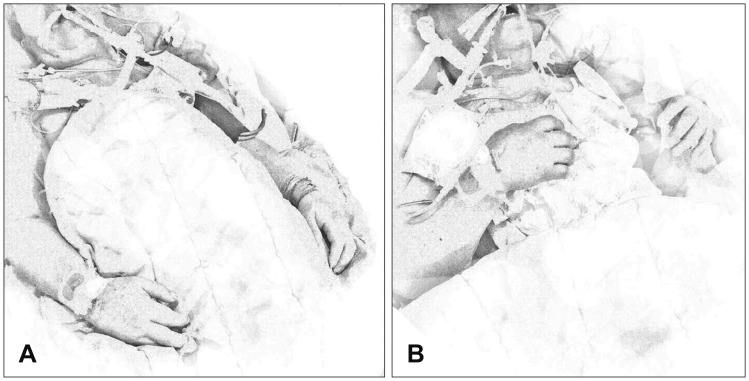Korean J Neurotrauma.
2017 Oct;13(2):153-157. 10.13004/kjnt.2017.13.2.153.
Chronic Brain-Dead Patients Who Exhibit Lazarus Sign
- Affiliations
-
- 1Department of Neurosurgery, Inha University School of Medicine and Hospital, Incheon, Korea. dkhyun@inha.ac.kr
- KMID: 2394552
- DOI: http://doi.org/10.13004/kjnt.2017.13.2.153
Abstract
- Lazarus sign, a complex reflex movement of the upper limbs after brain death, is a rare occurrence. We report two patients who showed a Lazarus sign following a diagnosis of brain death. It has been accepted that cardiac arrest usually occurs within 1 week after brain death; however, the two patients described herein survived for over 100 days after brain death was diagnosed. This report is intended to examine the relationship between the Lazarus sign and long-term survival after brain death, as well as to share our rare experience.
Keyword
Figure
Reference
-
1. Ad Hoc Committee of the Harvard Medical School to Examine the Definition of Brain Death. A definition of irreversible coma. Report of the Ad Hoc Committee of the Harvard Medical School to Examine the Definition of Brain Death. JAMA. 1968; 205:337–340. PMID: 5694976.2. Bueri JA, Saposnik G, Mauriño J, Saizar R, Garretto NS. Lazarus' sign in brain death. Mov Disord. 2000; 15:583–586. PMID: 10830429.
Article3. Heytens L, Verlooy J, Gheuens J, Bossaert L. Lazarus sign and extensor posturing in a brain-dead patient. Case report. J Neurosurg. 1989; 71:449–451. PMID: 2769397.5. Jorgensen EO. Spinal man after brain death. The unilateral extension-pronation reflex of the upper limb as an indication of brain death. Acta Neurochir (Wien). 1973; 28:259–273. PMID: 4773460.6. Lamb D. Death brain death and ethics. Albany, NY: State University of New York Press;1985.7. Machado C, Korein J, Ferrer Y, Portela L, García Mde L, Chinchilla M, et al. The Declaration of Sydney on human death. J Med Ethics. 2007; 33:699–703. PMID: 18055899.
Article8. Ropper AH. Unusual spontaneous movements in brain-dead patients. Neurology. 1984; 34:1089–1092. PMID: 6540387.
Article9. Saposnik G, Maurino J, Saizar R, Bueri JA. Spontaneous and reflex movements in 107 patients with brain death. Am J Med. 2005; 118:311–314. PMID: 15745731.
Article10. Shewmon DA. Chronic “brain death”: meta-analysis and conceptual consequences. Neurology. 1998; 51:1538–1545. PMID: 9855499.
Article11. Urasaki E, Fukumura A, Itho Y, Itoyama Y, Yamada M, Ushio Y, et al. Lazarus' sign and respiratory-like movement in a patient with brain death. No To Shinkei. 1988; 40:1111–1116. PMID: 3248188.12. Urasaki E, Tokimura T, Kumai J, Wada S, Yokota A. Preserved spinal dorsal horn potentials in a brain-dead patient with Lazarus' sign. Case report. J Neurosurg. 1992; 76:710–713. PMID: 1545268.
- Full Text Links
- Actions
-
Cited
- CITED
-
- Close
- Share
- Similar articles
-
- Delayed Presentation of Spontaneous Shockable Rhythm After Death: Another Subtype of Lazarus Phenomenon?
- Reflex Movements in Patients with Brain Death: A Prospective Study in A Tertiary Medical Center
- St. Lazarus and Hansen's disease.
- Recent Decrease in Organ Donation from Brain-Dead Potential Organ Donors in Korea and Possible Causes
- Successful Brain Dead Donor Management with CRRT: A Case Report








